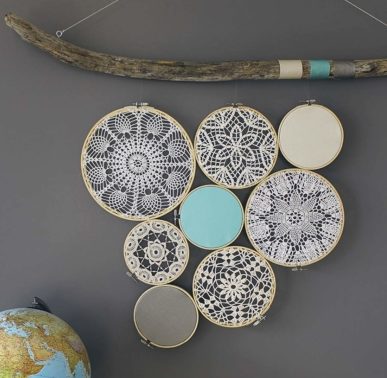Thank you for visiting!
Wow, what a beautiful book! It’s so fitting that such a lovely and carefully made book for such a lovely and carefully made craft. The excellent layout showcases step-by-step photography alongside clear descriptions. The dream catchers range from traditional to asymmetrical designs, to hoops which feature mobile-type elements hanging down, to full-on mobiles.
I love how the many different designs incorporate so many materials, including lots of natural elements, including beads, shells, feathers, flowers, and lacework. And yet, they all seem pretty quick and easy to make. Glue guns and other adult-level tools are needed for many designs yet, with some care, older kids could also enjoy making many of these. And the finished results are so beautiful — you could open a store with these dream catchers as the featured items!
As a graphic designer, I’ve noticed that for the past few years no illustrative style/medium has become more popular than watercolor. What I don’t think the many admirers realize is that so many professional artworks were actually created using (much easier to use) watercolor pencils instead of traditional media. This book is a wonderful introduction to the medium, offering both a guide and a set of ready-to-color coloring pages, with lovely outlined drawings, similar to an all-ages coloring book.
Here, however, the pages are quite thick, and the ready-to-color illustrations are rendered in a lighter gray, to better blend and enhance the completed paintings. The subjects range widely, and include wildlife, still life fruits, vehicles, jewelry, fishing lures, art nouveau figures, zodiac symbols, and vintage tattoo designs — something for everyone! The 16-page guide to using watercolor pencils is truly helpful and contains all you need to know to get started. The ready-to-paint part of the book offers over 30 pages of illustrations, printed on both sides, on thick cardstock.
Some close friends of ours owns a small wood furnishings factory. They’ve been gratifyingly successful yet, as interior design tastes change, I’ve been thinking that they ought to consider adding upholstered items to their offerings. But where to start? This beautiful,hardcover book is a complete beginners’ guide to upholstery. It is designed for those who want to redesign existing furniture but the concise, friendly, and knowledgeable information within, accompanied by a wealth of photos of each and every step, will be a great help to our friends.
The book offers quality paper with full-color printing for each page, bound within the hardcover by twin loop wire binding, so the book will lay flat during use. The introductory section, which includes descriptions of tools and materials needed, along with what a workshop needs, is alone worth the price of admission. The rest of the helpful “introduction” — all 66 pages of it — include topics like “timbers and textiles,” basic repair, skills needed, and more. Five varied projects follow — footstool, chair, bench, couch, headboard — with photos showing every step along the way. What a gift this book is!
In my work as a graphic designer, I have often turned to long out-of-copyright images of flowers and floral arrangements to repurpose in a wide variety of ways, from video to watercolors to collage to floral frames… and much more. Yet, in those years of work, I often found myself pondering what kind of flowers I was using, or when a vintage valentine might have been created, or what the original use was intended to be. Now, at last, I have my answers from this beautifully generous encyclopedic work.
Complete enough for any Ph.D. dissertation or master’s thesis, yet written in an engagingly informative style, the book focuses on a profusion of floral photos and scans of antique floral graphics from every conceivable source. Equal parts coffee-table book and graphic encyclopedia, every page is another delight with a complete range of (American) floral graphics from the earliest printings to today. The 224-page book is well-bound in softcover and printed on high-quality paper and divided into seven chapters with each focusing on a specific type of flower.





